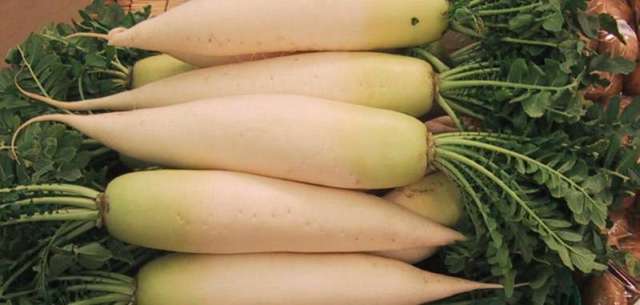I thought for sure that I was going to escape from that Mediterranean origin with the Daikon radish, but it turns out that it, too, came from the Cradle of Civilization. It moved to the Orient around 500 B.C. and it really came into its own in Asia. When it comes to using this amazing vegetable, Asians have the jump on the Western world. Over 90% of Daikon grown is in Asia. In the U.S., most of the commercial Daikon production is in California and a small percent in South Texas, around Houston. Some farmers use it as a fodder crop, leaving the roots in the ground and feeding the tops to their animals. So, we’re a little slow learning about this great vegetable.
I first started using Daikon about three years ago when I noticed the big white root vegetable in the grocery and was curious about the taste of this radish. Of course, after peeling it, I used it in a salad as I would a normal radish. It had a crisp, lightly peppery taste and was similar to the standard radish. Being on a quest for potato replacements, I tried cutting a few thin rounds and frying them and was pleased to find that they tasted great!
The picture at the top of the page gives you an idea of what the Daikon radish looks like, but mostly, I’ve seen them as a big, white root with the top and the bottom chopped off. Incidentally the name Daikon is two Japanese words, dai and kon that, respectively, mean ‘large” and “root”. It’s an apt description. They range from 2 to 4 inches in diameter and 6 to 20 inches long. In Asia, farmers have grown ones that weigh up to 50 pounds!
I have used Daikon in many ways, raw in salads, cooked in stews, stir fried, roasted, French fried and shredded into hash browns. After reading more about them, I am going to be using them many more ways. It’s a very versatile and overlooked vegetable. So, tell me, have you used Daikon in your cooking? If so, how have you used it?
Here’s a trio of recipes on Skinny Girl that use Daikon.
Welsh Broccoli and Bacon Soup
Summer Harvest Cauli-Risotto
Home-Style Veggies O’Brien
Nutrition Infomation for 1/2 cup (113.4 grams)
Calories: 12 Fat: 0.3 g Net Carbs: 1.1 g Protein: 0.0 g
Reference sites for this article include Wikipedia, The Tokyo Foundation and the Idaho Government.


Very interesting! I’ve never experienced any in all the Chinese restaurants we have reviewed. Next time we go I will have to ask if they have it any of their dishes.
Mee (The Chinese Quest)
I would be curious to know also. It could be shredded in a soup or a salad and not be noticeable.